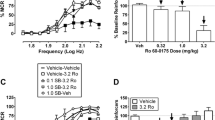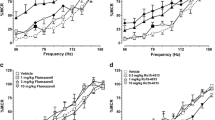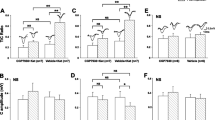Abstract
Rationale
GABAA positive allosteric modulators (GABAA PAMs), such as diazepam and zolpidem, are used clinically for anxiety and insomnia, but abuse liability is a concern. Novel GABAA PAMS may have lower abuse liability while retaining clinical utility.
Objective
The present study compared abuse-related effects of the non-selective GABAA PAM diazepam, the α1-selective GABAA PAM zolpidem, and three novel GABAA PAMs (JY-XHe-053, XHe-II-053, and HZ-166) using intracranial self-stimulation (ICSS) in rats. These novel compounds have relatively low efficacy at α1-, α2-, and α3-containing GABAA receptors, putative in vivo selectivity at α2/α3-containing GABAA receptors, and produce anxiolytic-like effects with limited sedation in non-human primates.
Methods
Adult, male Sprague-Dawley rats (n = 17) were each implanted with a bipolar electrode in the medial forebrain bundle and trained to respond under a fixed-ratio 1 schedule of reinforcement for electrical brain stimulation. The potency and time course of effects were compared for diazepam (0.1–10 mg/kg), zolpidem (0.032–3.2 mg/kg), and the three novel compounds (JY-XHe-053, XHe-II-053, and HZ-166; all 3.2–32 mg/kg).
Results
Zolpidem and diazepam produced transient facilitation of ICSS at small doses and more sustained rate-decreasing effects at larger doses. JY-XHe-053 and HZ-166 produced weak and inconsistent ICSS facilitation, whereas XHe-II-053 had no effect on ICSS.
Conclusions
These results support a key role for α1-containing GABAA receptors in mediating GABAA PAM-induced ICSS facilitation. These results are concordant with drug self-administration studies in monkeys in suggesting that GABAA PAMs with low α1 efficacy and putative α2/α3 selectivity have lower abuse liability than high-efficacy non-selective or α1-selective GABAA PAMs.




Similar content being viewed by others
References
Ator NA (2002) Relation between discriminative and reinforcing effects of midazolam, pentobarbital, chlordiazepoxide, zolpidem, and imidazenil in baboons. Psychopharmacology 163(3–4):477–487
Ator NA (2005) Contributions of GABA A receptor subtype selectivity to abuse liability and dependence potential of pharmacological treatments for anxiety and sleep disorders. CNS Spectr 10(1):31–39
Ator NA, Atack JR, Hargreaves RJ, Burns HD, Dawson GR (2010) Reducing abuse liability of GABAA/benzodiazepine ligands via selective partial agonist efficacy at α1 and α2/3 subtypes. J Pharmacol Exp Ther 332(1):4–16
Bauer C, Banks M, Blough B, Negus S (2013) Use of intracranial self-stimulation to evaluate abuse-related and abuse-limiting effects of monoamine releasers in rats. Br J Pharmacol 168(4):850–862
Bellantuono C, Reggi V, Tognoni G, Garattini S (1980) Benzodiazepines: clinical pharmacology and therapeutic use. Drugs 19(3):195–219
Carlezon WA, Chartoff EH (2007) Intracranial self-stimulation (ICSS) in rodents to study the neurobiology of motivation. Nature Protoc 2(11):2987–2995
Carter LP, Griffiths RR (2009) Principles of laboratory assessment of drug abuse liability and implications for clinical development. Drug Alcohol Depend 105(Suppl 1):S14–S25
Caudarella M, Campbell K, Milgram N (1982) Differential effects of diazepam (valium) on brain stimulation reward sites. Pharmacol Biochem Behav 16(1):17–21
Chouinard G (2004) Issues in the clinical use of benzodiazepines: potency, withdrawal, and rebound. J Clin Psychiatry 65(Suppl 5):7–12
Daeppen JB, Gache P, Landry U, Sekera E, Schweizer V, Gloor S, Yersin B (2002) Symptom-triggered vs fixed-schedule doses of benzodiazepine for alcohol withdrawal: a randomized treatment trial. Arch Intern Med 162(10):1117–1121
Dreifuss FE, Rosman NP, Cloyd JC, Pellock JM, Kuzniecky RI, Lo WD, Matsuo F, Sharp GB, Conry JA, Bergen DC (1998) A comparison of rectal diazepam gel and placebo for acute repetitive seizures. N Engl J Med 338(26):1869–1875
Dündar Y, Boland A, Strobl J, Dodd S, Haycox A, Bagust A, Bogg J, Dickson R, Walley T (2004) Newer hypnotic drugs for the short-term management of insomnia: a systematic review and economic evaluation. Health Technol Assess 8(24): iii-x, 1–125
Evans SM, Funderburk FR, Griffiths RR (1990) Zolpidem and triazolam in humans: behavioral and subjective effects and abuse liability. J Pharmacol Exp Ther 255(3):1246–1255
Fischer BD, Licata SC, Edwankar RV, Wang ZJ, Huang S, He X, Yu J, Zhou H, Johnson EM, Cook JM et al (2010) Anxiolytic-like effects of 8-acetylene imidazobenzodiazepines in a rhesus monkey conflict procedure. Neuropharmacology 59(7–8):612–618
Gomita Y, Ichimaru Y, Moriyama M (1983) Effects of benzodiazepines on low rate responding for low current brain stimulation rewards. Jpn J Pharmacol 33(2):498
Grant KA, Johanson CE (1987) Diazepam self-administration and resistance to extinction. Pharmacol Biochem Behav 28(1):81–86
Griffiths RR, Johnson MW (2005) Relative abuse liability of hypnotic drugs: a conceptual framework and algorithm for differentiating among compounds. J Clin Psychiatry 66(Suppl 9):31–41
Griffiths RR, Weerts EM (1997) Benzodiazepine self-administration in humans and laboratory animals—implications for problems of long-term use and abuse. Psychopharmacology 134(1):1–37
Griffiths RR, Bigelow G, Liebson I (1979) Human drug self-administration: double-blind comparison of pentobarbital, diazepam, chlorpromazine and placebo. J Pharmacol Exp Ther 210(2):301–310
Griffiths RR, Sannerud CA, Ator NA, Brady JV (1992) Zolpidem behavioral pharmacology in baboons: self-injection, discrimination, tolerance and withdrawal. J Pharmacol Exp Ther 260(3):1199–1208
Hajak G, Müller WE, Wittchen HU, Pittrow D, Kirch W (2003) Abuse and dependence potential for the non-benzodiazepine hypnotics zolpidem and zopiclone: a review of case reports and epidemiological data. Addiction 98(10):1371–1378
Holm KJ, Goa KL (2000) Zolpidem: an update of its pharmacology, therapeutic efficacy and tolerability in the treatment of insomnia. Drugs 59(4):865–889
Hughes A, Williams MR, Lipari RN, Bose J, Copello EAP, Kroutil LA (2016) Prescription drug use and misuse in the United States: results from the 2015 National Survey on Drug Use and Health. NSDUH Data Review
Inciardi JA, Surratt HL, Kurtz SP, Burke JJ (2006) The diversion of prescription drugs by health care workers in Cincinnati, Ohio. Subst Use Misuse 41(2):255–264
Jones JD, Mogali S, Comer SD (2012) Polydrug abuse: a review of opioid and benzodiazepine combination use. Drug Alcohol Depend 125(1–2):8–18
Kannampalli P, Babygirija R, Zhang J, Poe MM, Li G, Cook JM, Shaker R, Banerjee B, Sengupta JN (2017) Neonatal bladder inflammation induces long-term visceral pain and altered responses of spinal neurons in adult rats. Neuroscience 346:349–364
Lazenka MF, Negus SS (2017) Oral modafinil facilitates intracranial self-stimulation in rats: comparison with methylphenidate. Behav Pharmacol
Licata SC, Rowlett JK (2011) Self-administration of bretazenil under progressive-ratio schedules: behavioral economic analysis of the role intrinsic efficacy plays in the reinforcing effects of benzodiazepines. Drug Alcohol Depend 113(2–3):157–164
Mayo-Smith MF (1997) Pharmacological management of alcohol withdrawal: a meta-analysis and evidence-based practice guideline. JAMA 278(2):144–151
McClusky HY, Milby JB, Switzer PK, Williams V, Wooten V (1991) Efficacy of behavioral versus triazolam treatment in persistent sleep-onset insomnia. Am J Psychiatry 148(1):121–126
Möhler H, Crestani F, Rudolph U (2001) GABA A-receptor subtypes: a new pharmacology. Curr Opin Pharmacol 1(1):22–25
Naruse T, Asami T (1987) Intravenous self-administration of diazepam in rats. Eur J Pharmacol 135(3):365–373
National Research Council (2011) Guide for the care and use of laboratory animals. National Academies Press, Washington
Negus SS, Miller LL (2014) Intracranial self-stimulation to evaluate abuse potential of drugs. Pharmacol Rev 66(3):869–917
O’Brien CP (2005) Benzodiazepine use, abuse, and dependence. J Clin Psychiatry 66(Suppl 2):28–33
O’Connor EC, Chapman K, Butler P, Mead AN (2011) The predictive validity of the rat self-administration model for abuse liability. Neurosci Biobehav Rev 35(3):912–938
Olds ME (1966) Facilitatory action of diazepam and chlordiazepoxide on hypothalamic reward behavior. J Comp Physiol Psychol 62(1):136
Pakes GE, Brogden RN, Heel RC, Speight TM, Avery GS (1981) Triazolam: a review of its pharmacological properties and therapeutic efficacy in patients with insomnia. Drugs 22(2):81–110
Pauly V, Frauger E, Pradel V, Nordmann S, Pourcel L, Natali F, Sciortino V, Lapeyre-Mestre M, Micallef J, Thirion X (2011) Monitoring of benzodiazepine diversion using a multi-indicator approach. Int Clin Psychopharmacol 26(5):268–277
Pilotto R, Singer G, Overstreet D (1984) Self-injection of diazepam in naive rats: effects of dose, schedule and blockade of different receptors. Psychopharmacology 84(2):174–177
Ralvenius WT, Benke D, Acuña MA, Rudolph U, Zeilhofer HU (2015) Analgesia and unwanted benzodiazepine effects in point-mutated mice expressing only one benzodiazepine-sensitive GABAA receptor subtype. Nat commun 6:6803
Reynolds LM, Engin E, Tantillo G, Lau HM, Muschamp JW, Carlezon WA, Rudolph U (2012) Differential roles of GABAA receptor subtypes in benzodiazepine-induced enhancement of brain-stimulation reward. Neuropsychopharmacology 37(11):2531–2540
Riss J, Cloyd J, Gates J, Collins S (2008) Benzodiazepines in epilepsy: pharmacology and pharmacokinetics. Acta Neurol Scand 118(2):69–86
Rivas FM, Stables JP, Murphree L, Edwankar RV, Edwankar CR, Huang S, Jain HD, Zhou H, Majumder S, Sankar S, Roth BL, Ramerstorfer J, Furtmüller R, Sieghart W, Cook JM (2009) Antiseizure activity of novel ɣ-aminobutyric acid (A) receptor subtype-selective benzodiazepine analogues in mice and rat models. J Med Chem 52(7):1795–1798
Roache JD, Griffiths RR (1989) Diazepam and triazolam self-administration in sedative abusers: concordance of subject ratings, performance and drug self-administration. Psychopharmacology 99(3):309–315
Rowlett JK, Lelas S (2007) Comparison of zolpidem and midazolam self-administration under progressive-ratio schedules: consumer demand and labor supply analyses. Exp Clin Psychopharmacol 15(4):328–337
Rowlett JK, Platt DM, Lelas S, Atack JR, Dawson GR (2005) Different GABAA receptor subtypes mediate the anxiolytic, abuse-related, and motor effects of benzodiazepine-like drugs in primates. Proc Natl Acad Sci U S A 102(3):915–920
Rudolph U, Crestani F, Benke D, Brünig I, Benson JA, Fritschy J-M, Martin JR, Bluethmann H, Möhler H (1999) Benzodiazepine actions mediated by specific γ-aminobutyric acid(A) receptor subtypes. Nature 401(6755):796–800
Sanna E, Busonero F, Talani G, Carta M, Massa F, Peis M, Maciocco E, Biggio G (2002) Comparison of the effects of zaleplon, zolpidem, and triazolam at various GABA(A) receptor subtypes. Eur J Pharmacol 451(2):103–110
Shader RI, Greenblatt DJ (1993) Use of benzodiazepines in anxiety disorders. N Engl J Med 328(19):1398–1405
Shinday NM, Sawyer EK, Fischer BD, Platt DM, Licata SC, Atack JR, Dawson GR, Reynolds DS, Rowlett JK (2013) Reinforcing effects of compounds lacking intrinsic efficacy at α1 subunit-containing GABAA receptor subtypes in midazolam-but not cocaine-experienced rhesus monkeys. Neuropsychopharmacology 38(6):1006–1014
Siriwardena AN, Qureshi MZ, Dyas JV, Middleton H, Orner R (2008) Magic bullets for insomnia? Patients’ use and experiences of newer (Z drugs) versus older (benzodiazepine) hypnotics for sleep problems in primary care. Br J Gen Pract 58(551):417–422
Skolnick P (2012) Anxioselective anxiolytics: on a quest for the Holy Grail. Trends Pharmacol Sci 33(11):611–620
Stewart RB, Lemaire GA, Roache JD, Meisch RA (1994) Establishing benzodiazepines as oral reinforcers: midazolam and diazepam self-administration in rhesus monkeys. J Pharmacol Exp Ther 271(1):200–211
Straub CJ, Carlezon WA, Rudolph U (2010) Diazepam and cocaine potentiate brain stimulation reward in C57BL/6J mice. Behav Brain Res 206(1):17–20
Tan KR, Brown M, Labouèbe G, Yvon C, Creton C, Fritschy JM, Rudolph U, Lüscher C (2010) Neural bases for addictive properties of benzodiazepines. Nature 463(7282):769–774
Tracy ME, Slavova-Hernandez GG, Shelton KL (2014) Assessment of reinforcement enhancing effects of toluene vapor and nitrous oxide in intracranial self-stimulation. Psychopharmacology 231(7):1339–1350
Victorri-Vigneau C, Dailly E, Veyrac G, Jolliet P (2007) Evidence of zolpidem abuse and dependence: results of the French Centre for Evaluation and Information on Pharmacodependence (CEIP) network survey. Br J Clin Pharmacol 64(2):198–209
Woods JH, Winger G (1995) Current benzodiazepine issues. Psychopharmacology 118(2):107–115
Acknowledgements
The research was supported by the National Institutes of Health grants R01 NS070715 (SSN) and NS076517 and MH096463 (JMC). Additional support was provided by the Shimadzu Analytical Facility of Southeastern Wisconsin. All authors have made significant contributions to the research and manuscript, and all authors have read and approved the final manuscript.
Author information
Authors and Affiliations
Corresponding author
Ethics declarations
Experiments were performed with the approval of the Virginia Commonwealth University Institutional Animal Care and Use Committee in accordance with the National Institutes of Health Guidelines for the Care and Use of Laboratory Animals 8th edition (National Research Council 2011).
Conflict of interest
The authors declare that they have no conflict of interest.
Electronic supplementary material
ESM 1
(DOCX 151 kb)
Rights and permissions
About this article
Cite this article
Schwienteck, K.L., Li, G., Poe, M.M. et al. Abuse-related effects of subtype-selective GABAA receptor positive allosteric modulators in an assay of intracranial self-stimulation in rats. Psychopharmacology 234, 2091–2101 (2017). https://doi.org/10.1007/s00213-017-4615-8
Received:
Accepted:
Published:
Issue Date:
DOI: https://doi.org/10.1007/s00213-017-4615-8




